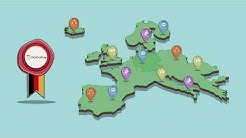DCAT-AP
DCAT - the Data Catalog Vocabulary is a so-called vocabulary to describe data catalogs and their contents (W3C, 2014). It is based on the Resource Description Framework (RDF), a web technology for modeling data structures. In line with the idea of Linked Data, DCAT is used to standardize web-based data catalogs and to enable systematic research, access and networking - both of the data and of the catalogs.
The vocabulary was further developed at the initiative of the European Commission into DCAT-AP, a so-called Application Profile for Data Portals in Europe. DCAT-AP is used by the European Data Portal and about 80 other catalogs from 36 European countries (as of March 2019), which are directly linked to the portal. The harmonization of the data with DCAT-AP makes it possible to systematically record the more than 800,000 data records with a single search, although the data is stored locally and made available and updated by various institutions in different languages and countries.
DCAT-AP in turn has several extensions that either represent national standards or address specific use cases. These include among others:
...national (DACH):
- DCAT-AP.de as common German metadata model for the exchange of open administrative data
- DCAT-AP for Switzerland as standard for Switzerland (all text elements must be multilingual in German, English, French and Italian)
- For Austria there is no DCAT-AP extension by name, on the other hand the Cooperation OGD Austria has developed a uniform metadata structure, which considers INSPIRE specifications as well as DCAT-AP. (See https://www.data.gv.at/katalog/dataset/metadaten_dokumenten/resource/4af3f912-3821-4183-ad7b-2a6c886fbdca)
...application-specific:
- StatDCAT-AP for cataloguing statistical data, developed in cooperation with Eurostat
- GeoDCAT-AP defines an RDF-based syntax (Syntax Binding) for metadata elements of geoinformation defined by the ISO 19115 standards and the [INSPIRE directive](https://inspire.ec.europa.eu/. This enables the networking of spatial data infrastructures (GDIs) with DCAT-AP-compatible data catalogs (e.g. GDI-DE data is also listed in the European Data Portal) as well as the cataloguing of spatial data sets with additional metadata fields.-
Take a look at this short info video about DCAT-AP.de:
DCAT-AP.de - the standard for the exchange of open public administration data 
